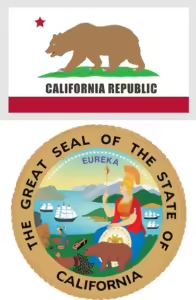President-Elect Trump vs. California: What Lies Ahead?
Will It Be Environmental Law & Policy Deja Vu All Over Again? Or Even Worse?
 Californians who care about the environment likely–and justifiably–feel whipsawed this week. Former President Trump (#45) has re-emerged as President-elect Trump (#47), interrupted by the intervening four years of the Biden-Harris presidential administration. (Actually, this presidential whipsaw has been going on for decades: think Bush Sr.-Clinton-Bush Jr.-Obama-Trump-Biden-Trump redux.)
Californians who care about the environment likely–and justifiably–feel whipsawed this week. Former President Trump (#45) has re-emerged as President-elect Trump (#47), interrupted by the intervening four years of the Biden-Harris presidential administration. (Actually, this presidential whipsaw has been going on for decades: think Bush Sr.-Clinton-Bush Jr.-Obama-Trump-Biden-Trump redux.)
In general, California’s progressive environmental laws and policies since the 1980’s have been in tension with federal environmental policies under recent Republican presidential administrations, while in relative harmony with environmental policies undertaken by Democratic presidents.
And then came Donald Trump.
Beginning in January 2017, environmental policy disagreements between California and the federal government under President Trump quickly morphed into four years of outright legal and political warfare. The first Trump administration announced plans to roll back dramatically or even eliminate a host of federal environmental policies embraced by previous Democratic and Republican administrations: Trump abruptly removed the United States from the 2015 Paris Climate Accord; attempted to dismantle national monuments in Utah; weakened longstanding federal air and water pollution control standards; tried to eviscerate the Endangered Species Act; and installed as leaders of the USEPA and Department of the Interior a host of industry representatives who were given marching orders by the White House to abandon those cabinet agencies’ core missions.
Several of Trump’s environmental rollbacks were particularly focused on California. One example is the Trump administration’s early decision to eliminate California’s ability to set motor vehicle emission standards more stringent than those USEPA adopts for most of the nation–as explicitly contemplated by Congress under section 209 of the federal Clean Air Act.
The State of California quickly responded by filing scores of lawsuits in federal courts challenging the Trump administration’s environmental rollbacks…and prevailed in nearly all of them.
Eventually, Trump became so exasperated that his administration decided to play offense: it sued California in a couple of instances, including one lawsuit challenging California’s greenhouse gas cap-and-trade program as unconstitutional. (California won that case too.)
In hindsight, the Trump administration failed to do all that much long-term damage to the nation’s environment. Nor was it successful in stifling California’s own, multifaceted pollution control, climate change and public health initiatives. That’s primarily because the political appointees charged with carrying out President Trump’s anti-environmental agenda were unseasoned and often downright incompetent. And the Trump anti-environment agenda itself was half-baked and not well thought out.
Conversely, California’s success in opposing Trump’s anti-environmental agenda was due primarily to strong policy leadership by Governors Jerry Brown and Gavin Newsom; solid technical support by the state’s respected environmental agencies; and terrific lawyering by the California Attorney General’s Office, which achieved a nearly perfect won-loss record in the courts.
That’s the good news.
Looking ahead to President-elect Trump’s second term, however, California’s task promises to be considerably more challenging.
That’s because, while in exile, Trump and his supporters appear to have learned from their mistakes and general ineffectiveness on the environmental front during his first term. The Heritage Foundation’s Project 2025 report contains a detailed–and quite alarming–list of recommendations as to how Trump & Co. can more effectively eviscerate federal environmental statutes and regulations. (While candidate Trump purported to dismiss the Project 2025 report on the 2024 campaign trail, don’t believe it for a second: President-elect Trump and his transition team will doubtless use the Heritage Foundation report as a playbook to guide their even deeper planned environmental rollbacks in his second term.)
Facing a second Trump administration, California’s political and environmental leaders have a most formidable and twofold challenge: first, to continue California’s national and international leadership on multiple environmental, natural resource and public health fronts. They’ll have to do so in the face of steady criticism and strong opposition from the incoming Trump administration.
Second, California will need to be even more vigilant and effective in opposing a multifaceted set of federal environmental, natural resource and public rollbacks to be anticipated from a Trump administration that’s likely to be far more savvy and strategic than it was in Trump’s first term. California can partner with other environmentally-conscious blue states–New York and Massachusetts come to mind–and with respected environmental non-profit organizations whenever possible. But California’s Governor, Attorney General and environmental agencies should be prepared to go it alone if and when necessary.
So buckle up, California: the next four years are going to be a very bumpy ride.
Reader Comments
One Reply to “President-Elect Trump vs. California: What Lies Ahead?”
Comments are closed.







One of our great achievements is that we have successfully exposed the great fraud of “climate mitigation” forever.
The authors and contributors on Legal Planet have never backed-up their preposterous mitigation assertions with scientific facts and empirical data.
Climate activists don’t want to be perceived as liars so now we see them abandoning and avoiding the term “climate mitigation”.
We must must continue to move forward and fight back against their organized swindling and theft of public resources.